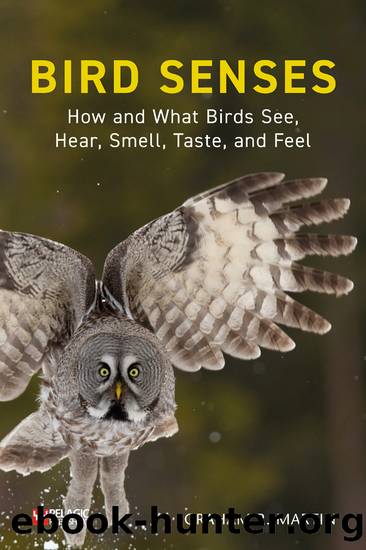Bird Senses by Graham R. Martin;

Author:Graham R. Martin;
Language: eng
Format: epub
Publisher: Book Network Int'l Limited trading as NBN International (NBNi)
Summary: hearing in birds
There is an ever-growing body of evidence that sounds are a key source of information for birds. Songs, calls, and instrumental sounds provide information that regulates the everyday social behaviour of birds. Researchers who study bird songs and calls have provided compelling evidence that these sounds have been shaped through natural selection to communicate details about the species, sex, and physiological state of individuals.
All of these acoustic signals employ a relatively narrow range of sound frequencies. Most songs and calls are within the frequency range 1â5 kHz, which is audible to humans (at least to younger humans). The sounds that birds rely on are therefore within the hearing of humans; there are no âsecretâ sound channels used by birds that humans cannot detect. Furthermore, because sensitivity to sounds in birds is similar to our own, or slightly lower, we should be able to hear the sounds produced by a bird at about the same distance as other birds in the locality.
Most bird species have a relatively poor ability to determine the direction and distance of a sound source. Even among songbirds, the accuracy with which they can identify the position of a sound source is not very great and is inferior to that of humans. Indeed, the range of a sound source may be determined only in broad categories. The actual position of a singing bird may be determined by approximations and approaches in a series of successive homing movements.
The direction and distance of a sound source can be determined with high accuracy by owl species. Even in these birds, however, sound range can be determined accurately over only a few metres. Furthermore, to be accurately located, the sound needs particular characteristics: it must have a wide range of frequencies, and it must continue for a few seconds or be frequently repeated. These are the sound characteristics of leaf litter or grass disturbed by an animal moving through it, and so it seems that the sound localisation of owls is adapted to the specific task of prey detection and capture.
In a handful of bird species active sonar underpins their use of deep caves as safe roosting and nesting sites. The resolution of this sonar is low and probably requires the birds to be highly familiar with a specific location.
Download
This site does not store any files on its server. We only index and link to content provided by other sites. Please contact the content providers to delete copyright contents if any and email us, we'll remove relevant links or contents immediately.
Whiskies Galore by Ian Buxton(40327)
Introduction to Aircraft Design (Cambridge Aerospace Series) by John P. Fielding(32337)
Rewire Your Anxious Brain by Catherine M. Pittman(17587)
Craft Beer for the Homebrewer by Michael Agnew(17445)
Cat's cradle by Kurt Vonnegut(13862)
Sapiens: A Brief History of Humankind by Yuval Noah Harari(13048)
The Tidewater Tales by John Barth(12029)
Leonardo da Vinci by Walter Isaacson(11901)
Underground: A Human History of the Worlds Beneath Our Feet by Will Hunt(11256)
The Radium Girls by Kate Moore(10906)
Thinking, Fast and Slow by Kahneman Daniel(10578)
The Art of Thinking Clearly by Rolf Dobelli(8841)
A Journey Through Charms and Defence Against the Dark Arts (Harry Potter: A Journey Throughâ¦) by Pottermore Publishing(7928)
Mindhunter: Inside the FBI's Elite Serial Crime Unit by John E. Douglas & Mark Olshaker(7833)
Wonder by R. J. Palacio(7058)
Turbulence by E. J. Noyes(7037)
Tools of Titans by Timothy Ferriss(6945)
Change Your Questions, Change Your Life by Marilee Adams(6639)
The Complete Stick Figure Physics Tutorials by Allen Sarah(6637)
